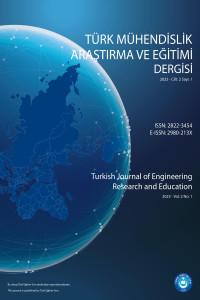Öz
The effects of steel fibers, or SF, on the tensile bond strength of the reinforced concrete beams, were studied
in an experimental investigation, the findings of which are presented in this paper. Tests show that the steel fibers
enhanced both the tensile bond strength of reinforced concrete beams and some of the mechanical properties of concrete.
The addition of steel fibers in the concrete mix improves some of the engineering properties of concrete such as the
compressive strength of cube, cylinder, and modulus of rupture, and decreases other properties namely: the modulus
of elasticity, and the indirect tensile test. The addition of steel fibers too leads to an increase in the ultimate bond strength
of the beams and delivers a lower deflection in the steel fibers reinforced concrete beams compare to the control beams.
This study led to the fact that It is recommended that a beam with a 43Ø lap length will fail at a load similar to the
datum beam, i.e. beam without lap. All the lapped beams reported bond failure lower than the datum beam. The
presence of steel fibers diminishes the slippage within the laps.
Anahtar Kelimeler
tensile bond strength steel fibers compressive strength deflection
Kaynakça
- State-of-the-Art Report on Fibers Reinforced Concrete. ACI Committee 544, 1R-96. 2002.
- F. Bencardino, L. Rizzuti, G. Spadea, R.N. Swamy, “Experimental evaluation of fiber reinforced concrete fracture properties,” Compos. B. Eng., vol. 41, no. 1, pp. 17-24, January 2010.
- Aminuddin Jamerana, Izni S. Ibrahima S., Siti Hamizah Yazan, Siti Nor A. A. Rahim, “Mechanical Properties of Steel-polypropylene Fibers Reinforced Concrete under Elevated Temperature,” in The 5th International Conference of Euro Asia Civil Engineering Forum (EACEF-5), Indonesia, 2015.
- Muneer K. Saeed, Muhammad K. Rahman, Mohammed H. Baluch, “Influence of steel and polypropylene fibers on cracking due to heat of hydration in mass concrete structures,” Struct. Concr., vol. 20, no. 2, pp. 808-822, Apr. 2019.
- BS 1881; testing Concrete Part 122 – Method of determination of water absorption. British Standard Institute London 1985.
- BSEN1230-6; testing hardened concrete – Part 6: Method of determination of tensile splitting strength: Making test cylinders from fresh concrete, 2000.
- BSEN 12390-5; testing hardened concrete – Part 5: Method of determination offlexural strength, 2000.
- BS 1881; testing Concrete Part 121 – Method of determination of static modulus of elasticity in compression. British Standard Institute London 1985.
- BSEN 12390-3; testing hardened concrete – Part 3: Method of determination of Compressive strength of cubes, 2000.
- Tarig M.A. Ahmed, A. A. Tair, “The effect of polypropylene and steel fibers on the engineering properties of concrete,” in 5th World Congress on Civil, Structural, and Environmental Engineering (CSEE'20), Lisbon, Portugal Virtual Conference, October 2020, Paper No. ICGRE 198.
Öz
Kaynakça
- State-of-the-Art Report on Fibers Reinforced Concrete. ACI Committee 544, 1R-96. 2002.
- F. Bencardino, L. Rizzuti, G. Spadea, R.N. Swamy, “Experimental evaluation of fiber reinforced concrete fracture properties,” Compos. B. Eng., vol. 41, no. 1, pp. 17-24, January 2010.
- Aminuddin Jamerana, Izni S. Ibrahima S., Siti Hamizah Yazan, Siti Nor A. A. Rahim, “Mechanical Properties of Steel-polypropylene Fibers Reinforced Concrete under Elevated Temperature,” in The 5th International Conference of Euro Asia Civil Engineering Forum (EACEF-5), Indonesia, 2015.
- Muneer K. Saeed, Muhammad K. Rahman, Mohammed H. Baluch, “Influence of steel and polypropylene fibers on cracking due to heat of hydration in mass concrete structures,” Struct. Concr., vol. 20, no. 2, pp. 808-822, Apr. 2019.
- BS 1881; testing Concrete Part 122 – Method of determination of water absorption. British Standard Institute London 1985.
- BSEN1230-6; testing hardened concrete – Part 6: Method of determination of tensile splitting strength: Making test cylinders from fresh concrete, 2000.
- BSEN 12390-5; testing hardened concrete – Part 5: Method of determination offlexural strength, 2000.
- BS 1881; testing Concrete Part 121 – Method of determination of static modulus of elasticity in compression. British Standard Institute London 1985.
- BSEN 12390-3; testing hardened concrete – Part 3: Method of determination of Compressive strength of cubes, 2000.
- Tarig M.A. Ahmed, A. A. Tair, “The effect of polypropylene and steel fibers on the engineering properties of concrete,” in 5th World Congress on Civil, Structural, and Environmental Engineering (CSEE'20), Lisbon, Portugal Virtual Conference, October 2020, Paper No. ICGRE 198.
Ayrıntılar
| Birincil Dil | İngilizce |
|---|---|
| Konular | İnşaat Mühendisliği |
| Bölüm | Araştırma Makalesi |
| Yazarlar | |
| Yayımlanma Tarihi | 21 Mayıs 2023 |
| Yayımlandığı Sayı | Yıl 2023 Cilt: 2 Sayı: 1 |


